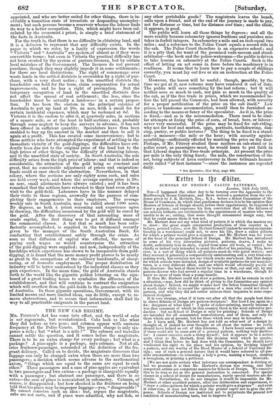rettr In 4t than.
SCHOOLS OF DESIGN: CALICO PATTERNS.
London, 14th July 1853.
Sue—I happened the other day to be turning over the Appendix to the Marlborough House Catalogue, and there noticed a quotation from the evi- dence given by J. B. Herbert, Esq., B. A., before a Select Committee of the House of Commons, in which that gentleman declares it to be his opinion that Masters of Schools of Design should, before their appointment, be required to draw a pattern ; and expresses his firm conviction that all the failures of our schools hitherto are attributable to the appointment of masters who were unable to do so ; adding, that some thought ornamental design easy, but that he could assure them it was not.
Mr. Herbert does not say what kind of pattern it is which the masters are to draw : the great staple ornamental production of this country is, I believe, printed calico ; now Mr. Herbert himself (unless he served an appren- ticeship in a warehouse) could not, to save his life, draw a calico pattern for which a printer would give a sixpence: and Mr. Herbert was for years at the head of the principal School of Design. Mr. Herbert has introduced in some of his very interesting pictures, patterns, drawn, I make no doubt, sufficiently true in style, copied from some old work, or varied ; but chiefly or indeed only intended to assist the effect of his painting. This, how- ever, is a sort of thing which all painters must do who paint stories ; and they account it generally a comparatively uninteresting and a very time-con- suming work, but certainly not one which cracks one's head. But that design for which schools were intended, design of available patterns for our manufac- tures, is a very different affair, and one which would effectually puzzle all the directors : the best of them would be beaten at that, out and out, by any pattern-drawer who had served a regular time in a warehouse, though he knew no more of taste than a pump-handle. If then Mr. Herbert could not draw a pattern, how did he remain in such a situation,—nay, how did he think of giving to the Committee any opinion about design ? Indeed, we might wonder how the Select Committee thought it worth their while to record the opinions of a man who could not draw a pattern, and why they did not rather address their inquiries to some expe- rienced designer.
It is very strange, what if it turn out after all that the people best fitted to direct Schools of Design are pattern-designers ! But here I am again in a fix : designers of what kind ? I spoke of calico-printing, merely because it was that ornament of which in this country there is the most extensive pro- duction : but no School of Design is only for printing ; Schools of Design are intended for all ornamental manufactures, and of them, not only for those which are at present, but for those which ever may be hereafter.
As I have said, Mr. Herbert has not told us what sort of a design he thought of, if indeed he ever thought at all about the matter : he really should have helped us out of this dilemma. I have heard some people ask if there could not be some sort of a general pattern, nothing very particu- lar: I cannot conceive such a thing myself; but it appears to be a notion quite clear to Mr. Herbert, from the decision with which he speaks ; and I think that before he had done with the Committee, he should have vindicated his right to his place and his opinion, by devising himself a pattern, and one worthy of the Head Master of a School of Universal De- sign ; one of such a general nature that it would have referred to all pos- sible ornamentation—to trimming a lady's gown, making a teapot, shaping [We are not quite certain what inference our correspondent is driving at, but we presume it is that Mr. Herbert's dictum was wrong, and that competent artists are competent masters for Schools of Design. We conceive this to be true so far as the general instruction is concerned. For special classes in a school of design for manufactures, surely special masters are de- sirable. Nevertheless, we do not imagine it would be impossible for Mr. Herbert or other qualified painter, after due deliberation and experiment, to "draw a calico-pattern for which a printer would give a sixpence" : and even if otherwise, it does not follow that the printer ought not to give the six- pence. Schools of Design are instituted not to perpetuate the present low condition of manufacturing taste, but to improve it.]


























 Previous page
Previous page